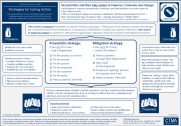The Setting Priorities and Taking Action Challenge
By Paul Linnell
A staggering finding from one of our benchmarking studies of top 200
companies
showed how few organisations effectively use data from customer feedback
and surveys to drive improvements and take action.
Many seem to have their CX improvement
“take action switch” set to a default setting
of “INACTION”, instead of a setting of “LET’S TAKE ACTION”. They’re almost stuck in a groove, looking for reasons and excuses for
“WHY we CAN’T do anything about it” instead of
actively looking for “WHAT CAN we do about
it”.
The “INACTION” setting often comes about because people think they
are far too busy to take action, or they think there’s
nothing they can
do to improve it.
But INACTION invariably means that they waste far
more time dealing with the problem over-and-over again, than if they had taken action to address it in the first place. The
reoccurrence of the problem will continue to have an impact on staff,
customers and the organisation, until eventually some type of action IS
taken.
What you’ll learn in this episode:
In this episode, I want to focus on a key technique you’ll need to call
upon, over and over again, as part of your customer experience
improvement programme.
I’m
going to talk about “Strategies for Taking Action”
and how to keep INACTION completely “off the table”.
Also mentioned in this episode
Next Episode: #004: The Enterprise Engagement Challenge
 Organisations that don’t treat their customer experience programme
as an enterprise-wide transformation, are typically hindered by a lack
of strategic purpose, limited cooperation, and an absence of measurable
benefits.
Organisations that don’t treat their customer experience programme
as an enterprise-wide transformation, are typically hindered by a lack
of strategic purpose, limited cooperation, and an absence of measurable
benefits.
It’s no wonder that so many organisations seem to have a
history of multiple attempts to launch projects to improve “customer
service”, “service quality”, “customer satisfaction”, and “customer
experience”, with each ending in eventual frustration and
disappointment.
In this episode, I look at three key elements that
should be included in a customer experience improvement programme to
help make it become an enterprise-wide, self-sustainable and successful
transformation that truly embraces customer excellence, and gets
everyone involved with a shared sense of purpose, collaboration and
accountability.
About Paul Linnell
 Paul Linnell is a customer experience and service quality
improvement champion, working internationally with senior managers
and their teams to help them achieve business success, reduce risk
and build customer loyalty and advocacy by taking actions to improve
customer experiences. Paul specialises in the design and deployment
of customer experience measurement, service quality improvement,
complaints handling and preventive analysis programmes. Industries
he has worked with include, Automotive, Consumer electronics,
Consumer goods, Electricity & Gas retail, Financial services,
Information technology, Local Government and Public Sector, Media /
Publishing, Passenger travel (Rail, Air and Sea), Pharmaceuticals
and Telecommunication. Paul has worked with clients and presented on
these subject at conferences and corporate events in the UK, Europe,
North America, the Middle East, Australia and New Zealand.
Originally from the UK and now based in New Zealand, he continues to
serve clients globally.
Paul Linnell is a customer experience and service quality
improvement champion, working internationally with senior managers
and their teams to help them achieve business success, reduce risk
and build customer loyalty and advocacy by taking actions to improve
customer experiences. Paul specialises in the design and deployment
of customer experience measurement, service quality improvement,
complaints handling and preventive analysis programmes. Industries
he has worked with include, Automotive, Consumer electronics,
Consumer goods, Electricity & Gas retail, Financial services,
Information technology, Local Government and Public Sector, Media /
Publishing, Passenger travel (Rail, Air and Sea), Pharmaceuticals
and Telecommunication. Paul has worked with clients and presented on
these subject at conferences and corporate events in the UK, Europe,
North America, the Middle East, Australia and New Zealand.
Originally from the UK and now based in New Zealand, he continues to
serve clients globally.




 Paul Linnell is a customer experience and service quality
improvement champion, working internationally with senior managers
and their teams to help them achieve business success, reduce risk
and build customer loyalty and advocacy by taking actions to improve
customer experiences. Paul specialises in the design and deployment
of customer experience measurement, service quality improvement,
complaints handling and preventive analysis programmes. Industries
he has worked with include, Automotive, Consumer electronics,
Consumer goods, Electricity & Gas retail, Financial services,
Information technology, Local Government and Public Sector, Media /
Publishing, Passenger travel (Rail, Air and Sea), Pharmaceuticals
and Telecommunication. Paul has worked with clients and presented on
these subject at conferences and corporate events in the UK, Europe,
North America, the Middle East, Australia and New Zealand.
Originally from the UK and now based in New Zealand, he continues to
serve clients globally.
Paul Linnell is a customer experience and service quality
improvement champion, working internationally with senior managers
and their teams to help them achieve business success, reduce risk
and build customer loyalty and advocacy by taking actions to improve
customer experiences. Paul specialises in the design and deployment
of customer experience measurement, service quality improvement,
complaints handling and preventive analysis programmes. Industries
he has worked with include, Automotive, Consumer electronics,
Consumer goods, Electricity & Gas retail, Financial services,
Information technology, Local Government and Public Sector, Media /
Publishing, Passenger travel (Rail, Air and Sea), Pharmaceuticals
and Telecommunication. Paul has worked with clients and presented on
these subject at conferences and corporate events in the UK, Europe,
North America, the Middle East, Australia and New Zealand.
Originally from the UK and now based in New Zealand, he continues to
serve clients globally.